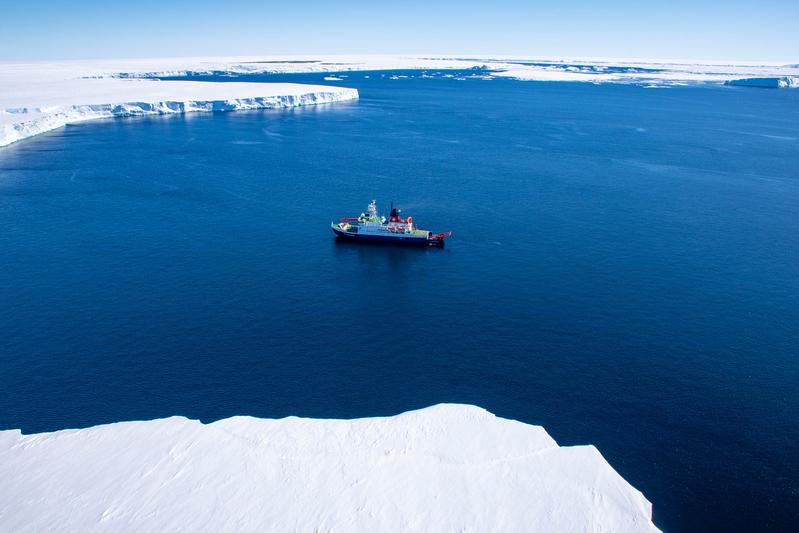Return from East Antarctica - Research Icebreaker Polarstern expected in Bremerhaven
After more than six months, the research icebreaker Polarstern is returning to its home port of Bremerhaven after a successful Antarctic season. The expeditions to the southern hemisphere and the transit there focussed on the oceanography and geology of East Antarctica as well as student training. Because of this special study area for the Polarstern, there was a change of personnel in Hobart, which was the first port call in Australia in her more than 40-year history.
The glaciers of East Antarctica are considered to be relatively stable compared to those in the west. However, in the course of global warming, not only the sea ice cover but also the ocean currents are changing. While the former is easily visible through satellite observations, for example, the latter is best investigated on site through direct measurements in the water column and deployment of buoys or moorings. During the last Antarctic season, scientists used the Polarstern to investigate the today’s current conditions and the composition of the water masses in great detail as part of the EASI expeditions. They also took samples from the seabed, as these sediment cores contain information about the flow conditions in the Earth's history.
From the Denman Glacier in East Antarctica (position about 66° South, 100° East), the Polarstern travelled about 2000 kilometres north to 45° south. Approximately every 100 nautical miles (185 kilometres), the expedition participants took water samples at a total of ten stations and determined the oxygen content and salinity, depth and temperature of the ocean from the surface to the sea floor. They then took sediment cores. “To my knowledge, such a long section with regular high-resolution samples from the water column and sediment through almost all climatically important areas of the Antarctic Circumpolar Current has never before been obtained from this part of the Indian Ocean,” says Dr Marcus Gutjahr, oceanographer at the GEOMAR Helmholtz Centre for Ocean Research, Kiel, and leader of the EASI-2 expedition.
“From the sediment cores, we can describe the position of the Antarctic Circumpolar Current in East Antarctica over the past 800,000 years,” adds Dr Oliver Esper, marine geologist at the Alfred Wegener Institute, Helmholtz Centre for Polar and Marine Research (AWI) and co-chief scientist of the expedition. This is particularly relevant because the fronts of the Antarctic Circumpolar Current tend to shift northwards in cold periods and southwards in warmer ones. “We were able to confirm that warm water is already reaching the Denman Glacier and melting it from below, which is leading to a rise in global sea levels. This is a condition that climate models predict for other areas in East Antarctica as global warming progresses in the coming decades. From the sediment cores, we will be able to estimate how quickly the ocean currents have shifted in the Earth’s history after the laboratory analyses that are now pending. This will enable us to improve forecasts of future sea level rise.”
Following the EASI-2 expedition and celebrations to mark Polarstern’s first port call in Australia, the EASI-3 expedition led by Prof Dr Sebastian Krastel (Kiel University) travelled from Hobart to Walvis Bay (Namibia). The focus here was even more on the geology of East Antarctica: the glacier retreats of older climates were investigated using geophysical methods. Using the structure of the sediment layers, the researchers can look back over 50 million years into the Earth’s history. In addition, a land team led by TU Dresden used global navigation satellite systems (GNSS) to record with high precision the movement of the Earth’s crust, which can be seen as a reaction to past and present ice mass changes. Together with geophysical measurements, the data should contribute to a better understanding of the deformation and internal structure of the Earth in the East Antarctic region.
Around a month ago, Polarstern then began its return transit through the Atlantic under the leadership of Simon Dreutter, who, together with a small team from the AWI bathymetry department, mapped the seabed for the GEBCO Seabed 2030 project using the ship’s own soundings. Last autumn, the handling of these soundings was the subject of a cruise by the Alfred Wegener Institute for student training as part of the POLMAR graduate school under the direction of Dr Claudia Hanfland.
The sediment cores and other cargo will be unloaded from the Polarstern on Monday. The ship is scheduled to arrive in Bremerhaven at around 17:00 on 12 May 2024 and spend the next four weeks in the Lloyd Shipyard for routine maintenance and repair work before setting sail for the Arctic at the beginning of June.
Weitere Informationen:
https://www.awi.de/en/about-us/service/press/single-view/forschungsschiff-polarstern-nimmt-kurs-auf-die-ostantarktis.html - background EASI expeditions
https://www.awi.de/en/about-us/service/press/single-view/forschungsschiff-polarstern-erstmalig-in-australien.html - Polarstern in Australia
Ähnliche Pressemitteilungen im idw


